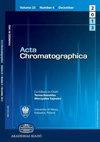一种用于分离酚酸的四乙二醇改性二氧化硅固定相
IF 1.7
4区 化学
Q3 CHEMISTRY, ANALYTICAL
引用次数: 0
摘要
摘要二氧化硅作为一种固定相,其分离效率较低,存在峰重叠、峰宽、峰尾现象,需要对其进行修饰以提高分离效率。本研究旨在开发一种由四乙二醇修饰的硅基固定相来分离酚类化合物。二氧化硅表面的硅醇基团与TEG通过3-缩水甘油氧基丙基甲氧基硅烷反应形成化学键,对二氧化硅进行改性。将改性后的二氧化硅装入毛细管柱中,用于分离由苯酚、邻苯二酚和邻苯三酚组成的简单酚类化合物。以0.2µL的样品进样,流动相为乙腈98%,流速为3 μL min - 1。在此过程中也进行等压洗脱,在254 nm波长下进行检测。简单酚类化合物混合物在不到7 min的时间内分离成功,不对称系数和分辨率分别为1.43 ~ 2.12和1.72 ~ 5.43。理论车牌的数量从213到7857不等。含有Si-TEG固定相的色谱柱也分离酚类化合物,包括没食子酸、丁香酸、阿魏酸和咖啡酸。将0.2µL的样品注入毛细管液相色谱,在不到12 min的时间内分离成功。样品用甲醇和50 mM磷酸盐缓冲液(pH为2.5(8:92))的混合物,流速为3 μL min−1等压洗脱。在280 nm波长处检测到酚酸类化合物。色谱图显示四个独立的峰。非对称系数和分辨率分别为1.53 ~ 1.63和1.14 ~ 1.74,但理论板数较低,仅为190 ~ 796块。本文章由计算机程序翻译,如有差异,请以英文原文为准。
A stationary phase of tetraethylene glycol-modified silica for separation of phenolic acids
Abstract Silica, as a stationary phase, has low separation efficiency accompanied by overlapping, broadened, and tailed peaks, so it needs to be modified to improve its efficiency. This study aims to develop a silica-based stationary phase modified by tetraethylene glycol (TEG) to separate phenolic compounds. Silica was modified by a chemical bond between silanol groups on the silica surface and TEG through a 3-glycidyloxypropylmethoxysilane reaction. The modified silica was packed into a capillary column and used to separate simple phenolic compounds consisting of phenol, pyrocatechol, and pyrogallol. A sample of 0.2 µL was injected into the capillary liquid chromatography and the mobile phase employed was acetonitrile 98% with a flow rate of 3 μL min −1 . Elution was also done isocratically in this process and detection was carried out at a wavelength of 254 nm. The mixture of simple phenolic compounds was successfully separated in less than 7 min. The asymmetry factor and resolution were 1.43–2.12 and 1.72–5.43 respectively. The number of the theoretical plates ranged from 213 to 7,857. Columns containing Si-TEG stationary phase also separate phenolic compounds, which consist of gallic acid, syringic acid, ferulic acid, and caffeic acid. A sample of 0.2 µL was injected into the capillary liquid chromatography and successfully separated the mixture in less than 12 min. The samples were eluted isocratically using a mixture of methanol and 50 mM phosphate buffer pH 2.5 (8:92) with a flow rate of 3 μL min −1 . The phenolic acids compounds were detected at a wavelength of 280 nm. The chromatogram showed four separate peaks. The asymmetry factor and resolution were 1.53–1.63 and 1.14–1.74, respectively, but the number of the theoretical plates was low, ranging from 190 to 796.
求助全文
通过发布文献求助,成功后即可免费获取论文全文。
去求助
来源期刊

Acta Chromatographica
化学-分析化学
CiteScore
4.00
自引率
0.00%
发文量
55
审稿时长
2.3 months
期刊介绍:
Acta Chromatographica
Open Access
Acta Chromatographica publishes peer-reviewed scientific articles on every field of chromatography, including theory of chromatography; progress in synthesis and characterization of new stationary phases; chromatography of organic, inorganic and complex compounds; enantioseparation and chromatography of chiral compounds; applications of chromatography in biology, pharmacy, medicine, and food analysis; environmental applications of chromatography; analytical and physico-chemical aspects of sample preparation for chromatography; hyphenated and combined techniques; chemometrics and its applications in separation science.
 求助内容:
求助内容: 应助结果提醒方式:
应助结果提醒方式:


